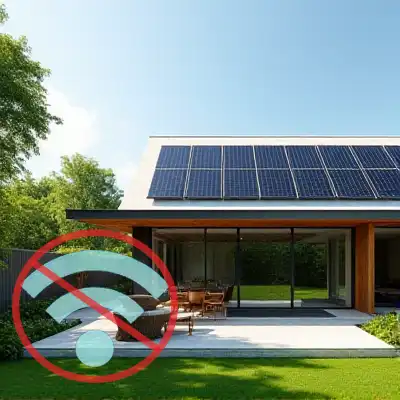How to Integrate Smart Home Devices Without Wi-Fi

Smart home technology has changed the way we interact with our living spaces, providing convenience, security, and energy efficiency through smart devices. The design of smart devices assumes that the room where they will be used has wireless internet (Wi-Fi), and this can be a serious drawback, especially for smart security systems. Is there a solution? Yes, there are several solutions that allow you to integrate smart home devices, without Wi-Fi. In this guide we will look at the different alternatives for smart devices that do not require wireless internet, their working principles and connection protocols, the best devices and give tips on how to install and configure them.
Table of Contents
Why Consider a Smart Home Without Wi-Fi?
Before diving into solutions, it’s important to understand why some homeowners prefer a non-Wi-Fi-based smart home system:
Improved Security: Wi-Fi-connected devices can be vulnerable to hacking and cyber threats. A wired or offline system reduces exposure to these risks.
More Reliable Performance: Wi-Fi networks can experience interference, slow speeds, or outages, impacting device functionality.
Lower Latency: Localized smart home systems, such as those using wired connections or mesh networks, often provide faster response times.
Reduced Electromagnetic Interference: Some people are sensitive to electromagnetic fields (EMFs) and prefer to limit their Wi-Fi usage at home.
Ideal for Remote Locations: Areas with poor internet connectivity may not support a Wi-Fi-based smart home setup effectively.
Alternative Smart Home Technologies Without Wi-Fi
If you want a smart home without Wi-Fi, here are the top alternatives:
1. Zigbee and Z-Wave Networks
Zigbee and Z-Wave are two of the most popular wireless protocols that work without a traditional Wi-Fi network. They use a mesh network to allow devices to communicate with each other through a central hub.
Zigbee: Operates on the 2.4 GHz frequency and is widely used in smart home automation.
Z-Wave: Uses lower frequencies (900 MHz), offering less interference and better range.
Pros:
Low power consumption
Strong network security
Reliable connectivity with minimal latency
Cons:
Requires a compatible hub (e.g., Samsung SmartThings, Hubitat, Home Assistant)
Limited direct compatibility with mainstream smart home assistants
2. Bluetooth Smart Devices
Bluetooth-enabled smart home devices connect directly to a smartphone, tablet, or a dedicated hub without needing Wi-Fi.
Best Uses:
Smart locks
Smart lights
Smart speakers
Pros:
Lower power consumption than Wi-Fi devices
No reliance on internet access
Secure, short-range connectivity
Cons:
Limited range (usually around 30-50 feet)
Devices may require manual operation when out of range
3. Wired Smart Home Systems (Ethernet-Based Solutions)
For homeowners looking for a high-performance and ultra-secure solution, wired smart home devices that use Ethernet cables are an excellent choice.
Best Uses:
Smart security cameras
Smart lighting systems
Smart hubs with wired connections
Pros:
Ultra-reliable connection without interference
Higher security against cyber threats
No dependency on Wi-Fi signal strength
Cons:
Requires additional wiring and setup
Less flexibility for moving devices around
4. Smart Hubs with Local Processing
Many smart home hubs allow devices to function locally without requiring an internet connection. Examples include:
Hubitat Elevation: A powerful local automation hub that supports Zigbee, Z-Wave, and LAN-connected devices.
Home Assistant: An open-source automation platform that runs locally without cloud dependence.
Apple HomeKit: Works with Bluetooth and Thread-based devices, with offline automation capabilities.
Pros:
No reliance on cloud servers
Faster response times due to local processing
Privacy-focused with minimal data sharing
Cons:
Requires initial setup and configuration
Limited third-party integrations for some brands
5. Infrared (IR) and Radio Frequency (RF) Controlled Devices
Some smart home devices use traditional IR or RF remote controls rather than Wi-Fi or wired connections.
Best Uses:
Smart TVs and entertainment systems
Smart air conditioners and fans
Motorized blinds and shades
Pros:
Works independently of the internet
Simple setup without additional hubs
Reliable and fast response times
Cons:
Requires direct line-of-sight for IR control
Limited automation features compared to other smart home technologies
Best Smart Home Devices That Work Without Wi-Fi
1. Smart Thermostats
Ecobee Smart Thermostat Premium (with local control features)
Honeywell Home T6 Pro (Z-Wave compatible)
2. Smart Lighting
Philips Hue (Zigbee-based with local bridge control)
Lutron Caseta Wireless (RF-based and works without Wi-Fi)
3. Smart Locks
August Smart Lock Pro (Bluetooth-enabled, local control options)
Schlage Encode Plus (Apple HomeKit Secure support)
4. Smart Security Cameras
EufyCam 2 Pro (local storage, no cloud required)
Reolink PoE Cameras (Ethernet-based, no Wi-Fi dependency)
5. Smart Plugs and Switches
Lutron Caseta Smart Plug (RF-controlled, hub-based)
Z-Wave Smart Plugs (for local automation hubs like Hubitat)
How to Set Up a Smart Home Without Wi-Fi
Choose Your Smart Home Ecosystem: Decide whether you want a Zigbee, Z-Wave, Bluetooth, or wired solution.
Invest in a Local Smart Hub: Consider options like Hubitat, Home Assistant, or Apple HomeKit for offline automation.
Ensure Device Compatibility: Check if your devices support non-Wi-Fi connectivity methods.
Set Up Automations Locally: Program schedules, routines, and triggers within your hub without relying on cloud-based controls.
Use Wired Solutions Where Possible: Ethernet-based smart cameras, lighting, and hubs ensure a stable, high-speed connection.
Maintain Security and Updates: Regularly update firmware and keep physical security in mind, especially for Bluetooth and RF devices.
Final Thoughts
A smart home without Wi-Fi is not only possible but can also be more secure, reliable, and efficient. Whether you choose Zigbee, Z-Wave, Bluetooth, or wired alternatives, the right combination of devices and local processing hubs can give you complete control over your home automation without relying on the internet. With careful planning, you can enjoy the benefits of smart living while minimizing connectivity concerns.